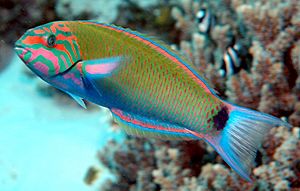Moon wrasse facts for kids
Quick facts for kids Moon wrasse |
|
|---|---|
 |
|
| Conservation status | |
| Scientific classification | |
| Synonyms | |
|
The moon wrasse (Thalassoma lunare) is a colorful fish found in the warm waters of the Indian Ocean and the western Pacific Ocean. You might also hear it called the crescent wrasse or lyretail wrasse because of its unique tail shape. These fish love to live around coral reefs and nearby areas. They can be found swimming at depths from about 1 to 20 meters (3 to 65 feet).
Moon wrasses are active hunters. They mostly eat fish eggs and small creatures that live on the ocean floor. This amazing fish can grow up to 45 centimeters (18 inches) long! People sometimes catch them for food, but they are more popular as pets in aquariums.
Contents
What Does a Moon Wrasse Look Like?
Moon wrasses change their look as they grow up. When they are young, called juveniles, their lower body is blue. They have a black spot in the middle of their top fin and another black mark near their tail.
As they get older, that black spot on their top fin changes. It turns into a bright yellow crescent shape, which is why they are called "moon" or "crescent" wrasses. Their main body becomes a vibrant green. You can see their scales clearly marked. Their head can be blue or even a purplish-red color. It often has a cool, broken checkerboard pattern.
Moon Wrasse Behavior
Moon wrasses are known for being very active fish. They are always on the move during the day! They also like to have their own space. If other fish get too close, moon wrasses might nip at them or chase them away.
These fish are diurnal, meaning they are awake and active during the day. They have excellent eyesight, which helps them find food and avoid danger. They also have a good sense of smell.
When night comes, moon wrasses need a safe place to rest. They often find cozy spots under rocks or other structures. Sometimes, if a space isn't big enough, a moon wrasse will dig it out. They do this by swimming through the spot over and over until it's just right.
How Moon Wrasses Reproduce
Moon wrasses have a very interesting way of reproducing. They are hermaphrodites, which means they can change their sex. All moon wrasses start their lives as females. Later, some of them will change into males. For the moon wrasse, this change can happen quite quickly, sometimes in just 10 days!
Some moon wrasses live in groups. These groups usually have one strong, dominant male. This male is like the leader. He lives with a "harem" of about a dozen other wrasses. Some of these are females, and some are males that are not dominant.
The dominant male is usually the most brightly colored fish in the group. During low tide, his color changes from green to blue. He then swims around, attacking and nipping at the other wrasses in his group. This shows his dominance. During the breeding season, before high tide, the dominant male turns completely blue. He then gathers all the females, and they begin to breed.
Moon Wrasses in Aquariums
Moon wrasses can live for a long time, sometimes up to 10 years, if they are kept in aquariums. In the wild, their lifespan is usually shorter. They are very popular fish for home aquariums. People like them because they are tough and can handle different conditions. They also have bright colors and interesting behaviors.
Aquarium owners especially like moon wrasses because they can tolerate changes in water quality, like spikes in nitrite. They are also helpful because they eat bristle worms. These worms can sometimes become a pest in home aquariums.


